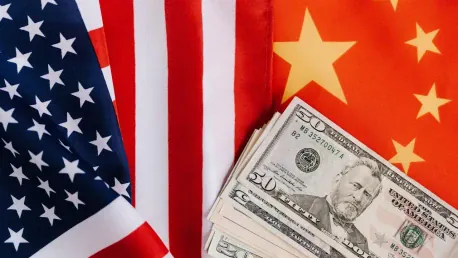The growing concern over China’s economic practices has prompted Western nations, particularly the United States, to explore strategies to counteract Beijing’s predatory trade tactics. The idea of an economic coalition, akin to NATO, has surfaced as a potential means to confront these issues. Understanding China’s historical economic policy shifts, the entrenched interdependencies between China and Western economies, and the intrinsic challenges of forming such a coalition are vital to framing an effective and practical response.
Historical Context and China’s Shift in Economic Policy
China’s economic landscape has been a roller-coaster of transformations, each significantly impacting its relationship with the global economy. Initially, under Chairman Mao Zedong, the People’s Republic of China adopted a rigid stance of economic self-reliance, which stifled its economic progress. This inward-focused policy, aimed at reducing dependence on foreign influence, led to inefficiencies and stagnation. By the late 1970s, under the leadership of Deng Xiaoping, China pivoted towards global economic integration, opening its markets, and embracing foreign direct investment. This strategic shift catalyzed unprecedented economic growth, benefiting China and creating lucrative opportunities for its international partners.
However, since Xi Jinping assumed power in 2012, there has been a noticeable shift back towards emphasizing self-reliance, particularly in advanced manufacturing. This policy seeks to reduce dependency on foreign technology and promote indigenous innovation. While aimed at fostering national strength, it has created friction with global economic partners, particularly the United States. The shift is seen as a direct challenge to the established economic order and has raised concerns about fair trade practices and global market stability.
Interdependencies and Decoupling
Despite vocal political calls for economic decoupling from both Washington and Beijing, the economic interdependencies between the U.S. and China are deeply entrenched and intricate. Trading over $600 billion in goods and services annually, both nations are significantly intertwined, making any clean decoupling a complex endeavor. China’s reliance on imports for essentials such as food, energy, and advanced manufacturing components underscores the multifaceted nature of these dependencies.
The global economy is a delicate web of interconnections where both the U.S. and China play pivotal roles. Numerous countries around the world depend heavily on trade with one or both of these superpowers. Any serious attempt at decoupling would likely result in substantial economic disruptions, affecting not just the U.S. and China but reverberating through the entire global economic landscape. As such, the idea of a complete break from China seems more politically driven than practically feasible, highlighting the complications in pursuing such a strategy.
Supply Chain Dynamics
The diversification of global supply chains over the past few decades has added another layer of complexity to the prospect of forming a cohesive Western economic response to China’s practices. By spreading manufacturing and sourcing across multiple countries, companies have minimized the influence of any single market hub. This has reduced both risks and leverage that any one country might have traditionally enjoyed, thus increasing the difficulty of forging a united economic front against China.
Smaller economies, especially those highly reliant on trade with China, are particularly hesitant to support punitive actions. Their economic survival hinges on these trade relationships, and any disruption could spell severe economic consequences. This underscores the challenge Western nations face in attempting to build a coalition—the economic stakes are too high for smaller countries to risk antagonizing a major trade partner like China without ironclad assurances of economic benefits. Therefore, while diversification of supply chains is intended to reduce vulnerabilities, it paradoxically complicates the effort to form a decisive and aligned Western economic response.
Challenges in Creating a NATO-like Economic Alliance
The notion of creating a NATO-like economic alliance to counter China’s coercive trade practices is theoretically appealing but fraught with practical difficulties. Smaller economies, which are deeply dependent on trade with both China and the United States, face significant risks in aligning against China without guaranteed economic benefits. Their integration into the global economy means that any punitive measures taken against China could adversely affect their own economic stability.
Additionally, China’s Made in China 2025 initiative, aimed at advancing self-sufficiency in high-tech industries, highlights Beijing’s ongoing struggle to reduce reliance on imported components. Despite ambitious goals, China remains heavily dependent on foreign technology, and this leaves it vulnerable. Nevertheless, the reliance on imports complicates the attempt to form a cohesive Western economic front. Industries across the globe that supply these necessary components need stable trade relationships to thrive, and upending these relationships could result in substantial economic fallout.
High-Tech Dependencies
China’s reliance on Western nations for critical high-tech components, such as semiconductor manufacturing equipment and aviation technology, underscores a fundamental vulnerability in its drive towards self-reliance. Within several high-tech industries that Beijing aims to dominate, more than half of the advanced components are still sourced from abroad. This dependency illustrates the significant barriers China faces in achieving full economic independence, even under the ambitious Made in China 2025 plan.
Despite these clear vulnerabilities, constructing a cohesive Western economic coalition is no straightforward task. Smaller countries are understandably reluctant to jeopardize their vital trade relations with China. Economic backlash and uncertainty loom large, making the stakes too high for countries to align fully against China without trustworthy compensation or substantial economic safety nets. This dependency on high-tech components reveals that while China’s ambitions are significant, the realization of an entirely self-reliant economy remains distinctly challenging.
The Prospect of an Economic NATO
The concept of an economic NATO to counter China’s predatory trade practices presents an alluring solution, but its practical application raises numerous questions. Establishing such an alliance would necessitate clear definitions of the economic coercion it aims to counter and the proportionality of its responses. The varied economic interests and dependencies among the countries considering joining such an alliance further complicate its formation.
The reluctance of smaller nations to align against China without assured compensations underscores the realpolitik of international trade relations. The geopolitical landscape is not merely about confronting a single nation’s practices but balancing the broader spectrum of economic interests that sustain national economies. As such, while the concept of an economic NATO is theoretically robust, its feasibility in practical terms remains questionable.
Role of the World Trade Organization (WTO)
Rather than embarking on the complex and potentially divisive task of forming a new economic alliance, leveraging the World Trade Organization (WTO) may provide a more pragmatic solution. Despite facing criticism for inefficiency and slow response times, the WTO offers an established multiparty forum with mechanisms explicitly designed for dispute resolution. Utilizing this platform to address China’s economic practices could present a unified front within an existing structure, thus avoiding the challenges associated with building a new coalition.
Leveraging the WTO’s mechanisms allows for a multipronged approach to mitigating China’s predatory economic practices, drawing on existing international agreements and diplomatic expertise. However, improving the WTO’s effectiveness requires concerted efforts to expedite resolutions and enhance its enforcement capabilities. As international pressures mount, reinforcing the WTO’s role might offer a more achievable and stable route than attempting to create a new, untested economic alliance.
Summary
The escalating concern over China’s economic strategies has led Western countries, especially the United States, to consider approaches to mitigate Beijing’s aggressive trade practices. One emerging concept is the creation of an economic alliance comparable to NATO, aimed at addressing these challenges. To develop an effective and realistic response, it is crucial to grasp China’s historical shifts in economic policies, the deep-rooted economic interdependencies between China and Western nations, and the inherent difficulties of establishing such an alliance.
China’s economic maneuvering has often involved state-driven directives and strategies that other nations perceive as unfair or predatory. This has created a complex network of dependencies, as many Western economies are deeply intertwined with China’s supply chains and markets. The formation of an economic coalition would involve navigating these dependencies, which is no small feat.
Moreover, establishing such a coalition requires member nations to align on objectives and strategies, something that is challenging given the diverse economic interests at play. The coalition would need to strike a balance between pushing back against unfair practices and maintaining beneficial economic relationships. Understanding these dynamics is essential for framing a coalition that is not only effective but also practical. This proposed alliance could serve as a counterbalance to China’s influence, ensuring fairer trade practices and protecting the interests of member nations.









